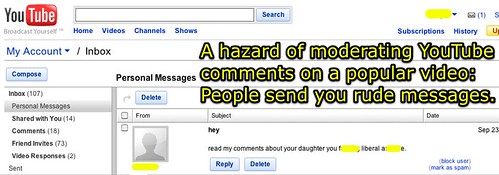I’m glad to still be moderating comments on Sarah’s video response to President Obama’s speech to students several weeks ago, rather than leaving comments open without moderation. The video has received over 180,000 views worldwide to date, and while the comment discussion has thankfully become MUCH less active than it was immediately following the speech, at least 15 – 25% of the comments which people are leaving now are still inappropriate – including profanity, personal attacks, or worse. One hazard of moderating comments on a popular YouTube video like this is direct YouTube messages from users, like the one below.
At some point I may turn new comments off entirely on this video, but it is not that time consuming to “check in” on it every few days and moderate the five to ten new comments which have come in. I wonder if direct messages like this one would cease altogether if I just turned off commenting? I am not sure. My sense has been that it is better to let people comment directly on the video rather than resort to ONLY being able to message me directly through YouTube. People who have messaged me directly have, like the person whose comment is above, been angry more over the fact that their comment / voice has been moderated / censored than they were over something actually in the video.
As I noted in my September 10th post, “Criteria for moderating comments on a viral video,” YouTube is in many ways a mirror for our global society in general. It is saddening to see how much anger, hate, and desire to hurt others there is in the comments people leave.
This entire experience with Sarah’s video has been a big learning experience for me as well as our family. On a YouTube technical note, I did not realize YouTube video publishers have to manually approve any “video responses” before they show up on the actual video. I noticed this evening, checking my YouTube inbox, that a response video from September 10th (which I did see at that time) never was “approved” to be an acknowledged response. I went ahead and approved it tonight, and chose to “ignore” a second response which was a spam video.
Overall, one of the lessons I take from this YouTube video moderation experience is how pervasive the human desire to speak out and be heard is. How many opportunities do we give students in our schools today to express themselves and interact with each other publicly online? I am not suggesting we should use YouTube as the primary sandbox for students learning appropriate social networking behavior. I AM suggesting that we need to provide students with MANY more opportunities to express their ideas and interact with others on the public web, as a part of their work during and after school. This recommendation is actually in line with the National School Board Association’s 2007 commissioned report, “Creating and Connecting/Research and Guidelines on Online Social-and Educational-Networking.” Convincing school leaders of the need for this change remains as challenging today in 2009 as it was in 2007, however.
Sarah and I were guests on the Seedlings webcast this past Thursday, and we both discussed some of the things we’ve learned as a result of this YouTube video experience. The audio recording and text chat of that webcast is available on EdTechTalk.
Technorati Tags:
youtube, video, moderate, moderation, socialnetworking, school, New Tag, education
If you enjoyed this post and found it useful, subscribe to Wes’ free newsletter. Check out Wes’ video tutorial library, “Playing with Media.” Information about more ways to learn with Dr. Wesley Fryer are available on wesfryer.com/after.
On this day..
- Beware of Phishing Cell Phone Calls: Don’t Share Personal Info with Strangers – 2018
- How to use your iPad and iPhone / iPad Touch with an External Display / Projector – 2010
- Content Filtering in Schools: Striving to CONTROL user behavior – 2007
- Many more K-12 Online Conference Teasers – 2007
- Mike Lawrence on DOPA – 2006
- British teachers support instructional autonomy – 2006
- Nontraditional peer review – 2006
- Deep tagging video – 2006
- Our need for more dialog in the face of fear – 2006
- Blog Search Tools – 2005


Comments
One response to “A hazard of moderating comments on a popular YouTube video”
Very well written and very insightful. It is interesting to “watch” human behavior manifest itself online.